Tokomairiro High School 2024 Annual Report



Board member names
Joe Herbert (Presiding Member)
Kerri Clarke
John Keoghan
Tony Mallon
Tania Jacobs
Alan Robinson
Matt Hutton
George Stark
Date that the board member’s term finishes
September 2025
September 2025
September 2025
September 2025
September 2025
September 2025
September 2024
September 2025
Strategic Goal 1:
Excellence in Teaching and Learning so that all ākonga can find their own voice and develop the self-assurance and skills to achieve their dreams.
Annual Target/Goal:
Raise student achievement in literacy and numeracy across the curriculum.
To have at least 70% of eligible Year 11 students attain the co requisites in literacy and numeracy.
NCEA Goals are 70% at Level 1; 85% at Level 2; 80% at Level 3; 40% UE and to increase the number of endorsements and have at least one excellence endorsement.
To have at least 90% of students at or above the expected level in Reading, Writing and at least 70% of students at or above the expected level in Mathematics. Actions
List all the actions from your Annual Implementation Plan for this Annual Target/Goal.
Action 1
Priority learners identified, monitored and reported to the Board regularly
Action 2
To further embed structured literacy
Action 3
To develop explicit teaching of literacy and numeracy across the curriculum
Action 4
Develop Professional growth cycle for all teaching staff
Action 5
To investigate and incorporate numeracy programmes to develop numeracy skills
Priority learners were identified in literacy and plans were made to enable some learners to complete courses in literacy as well as English in years 9 and 10.
In Mathematics priority learners were identified as part of the ALiM programme.
Other priority learners were identified by the Leaning Support who worked with NCEA students to enable more students to access SAC conditions.
SPEC programme ran for students in Year 913
Structured literacy was taught across the cohort in Year 7 and 8.
Selected students were taught structured literacy in years 9-13 this was dependent on literacy levels.
All departments made a focus of embedding more literacy and numeracy teaching in their curriculum areas.
Documentation was shared with all staff at the start of the year. Time was identified for all staff to meet in their groups to discuss and monitor goals. All documentation was completed at the end of the year.
We were part of the ALiM programme. Programmes for numeracy were investigated and chosen for Y7/8 Maths.
A review of Y9/10 maths took place and changes to the Y9/10 programme took place to enhance the learning and preparation for the CAAs.
Department reports and meeting minutes.
ALiM report
1st student attained the SPEC qualification PD on Common Assessment ActivitiesStudent preparedness for CAAs – small groups for priority learners.
NCEA Level 1 and 2 students at risk, plans developed. Some returned throughout study leave until December.
Tripled the use of SAC conditions. PD with teacher aides around SAC conditions.
Department reports
Structured literacy data
Department planning of structured literacy. Class list of priority students who took both Literacy and English
Department minutes
Staff Meeting minutes
HOD meeting minutes
SLT meeting minutes Staff on PD
PGC documentation collecting from all staff. Anecdotal data that staff were happy with the process.
Google Classroom (Staff)
Visit from the MOE checking ALiM PowerPoint of ALiM Year 9-10 planning + overview. New resources purchased. Math Mate implementation.
Reasons for any differences (variances) between the target and the outcomes Think about
Most of the year without an LSC. New SENCO into position – needed PD. ALiM programme ran by teacher, first year teaching Mathematics.
Planning for next year – where to next? What do you need to do to address targets that were not achieved.
Consider if these need to be included in your next annual implementation plan.
Earlier/more planning for Priority learners at department level – overseen by HODs. BOT meeting with all HODs to evaluate each departments progress.
Several new staff and new teachers joined the kura in 2024. 33% of the staff were 1st or 2nd year teachers.
New staff are getting Professional Development for structured literacy. Share structured literacy to the staff.
Continue to discuss literacy and numeracy as a whole staff.
Engage with Te Manu Ka Rere literacy support.
To have clearer scheduled meetings Make staff more accountable for their PD –feedback given to Principal monthly. Professional readings introduced.
To be discussed at a strategic level.
Strategic Goal 2:
Grow cultural awareness and develop a greater sense of belonging so that all ākonga feel a sense of connection to the school. Annual Target/Goal:
All staff making measurable progress toward Level 5 in the school’s Culturally Responsive Matrix Actions
List all the actions from your Annual Implementation Plan for this Annual Target/Goal.
Action 1
Consult with community including Māori learners
Action 2
Review PB4L practices and develop Tier 2 interventions
Action 3
Analyse KAMAR data for trends
Action 4
Develop school wide wellbeing strategies and develop an action plan
Action 5
Positive communication and celebration of learning/achievements
What did we achieve?
What were the outcomes of our actions? What impact did our actions have?
Some verbal consultation was carried out at parent teachers meetings.
Action 6
Teachers participate in learning haka/waiata
Action 7
Teachers professional goal to develop cultural competency as part of professional growth cycle
Staff attended PD targeting Teir 2 interventions.
Structure of pastoral team meetings reflect the shift in thinking – data driven.
Attendance and pastoral data was analysed frequently.
The wellbeing team developed a framework for a schoolwide wellbeing plan.
New recognition system
New effort grade system PB4L Monthly Awards Awards at Assembly – e.g. End of Term Genesis and Facebook
Staff learned two new waiata for the cultural competition. Staff also spent time learning the school haka.
All teaching staff had a goal around cultural competency
Evidence
This is the sources of information the board used to determine those outcomes.
Data from PB4L
Minutes from Pastoral Meetings PB4L Minutes
House Teaching Meeting Minutes
Board reports Data on KAMAR Pastoral Team Meetings
Minutes from meetings BOT report.
As per social media and Genesis editions. Fortnightly reports to whanau. Front entrance to school – PB4L awards Toko TV
Cultural performance Waiata performed in assembly every week Toko TV Episode
Professional Growth Cycle documentation. Survey results from teachers showed a greater confidence in the structure of the PGC during 2024.
Reasons for any differences (variances) between the target and the outcomes
Think about both where you have exceeded your targets or not yet met them.
New leadership took over many challenges. Consultation occurred at the end of 2023.
Consultation process was not fit for purpose, redesigned for use in 2025.
Planning for next year – where to next?
What do you need to do to address targets that were not achieved.
Consider if these need to be included in your next annual implementation plan.
Will use new process form community consultation in 2025.
We were receiving support with this as part of PLD with an external provider but this was discontinued. This slowed progress. Also we had a significant number of new staff in 2024.
Exceeding expectations – change in school culture. Whanau comments and engagement with kura high.
Using the revised effort score system to streamline the ability to identify Teir 2 and 3 behavior.
HOD tracking academic grades over time. Global mark books for literacy and numeracy.
To develop the wellbeing plan and implement it.
Reactivation of student success profiles. Embed the changes for long term success.
Staff confidence was a major factor in this. Staff were a lot more comfortable and looked forward to learning waiata for the performance.
There was a clearer process with allocated time for groups to meets. Goals were more specific to ensure that they aligned with the strategic goals of the school. Documentation was reviewed and made more user friendly as a result staff engagement in the process improved.
Staff to learn additional waiata from this years performance.
To enhance the process further so that professional reading becomes part of the process and to also use this process to ensure accountability of professional learning.

Modest gains across the board. A notable increase in students reaching 'Well Above' (0% → 24%), especially among male students.
Māori vs. Non-Māori Students:
- Māori students: Movement into 'Well Above' increased from 0% to 50%; 'Below' dropped from 50% to 0%.
- Non-Māori students: Slight reductions in 'Well Below' and 'Below'. More students reached 'Above' and 'Well Above'.
Gender Differences:
- Male students: 'Well Above' jumped from 0% to 27%; slight regression in the 'Meets' band.
- Female students: Increase in students reaching 'Above' and 'Well Above' (from 0% to 20%).

Results were consistent with slight movement across bands; girls were more evenly spread across categories.
Māori vs. Non-Māori Students:
- Māori students: Even spread with some decline in 'Meets.'
- Non-Māori students: Slight increase in 'Meets' and 'Well Above.'
Gender Differences:
- Male students: Increase in 'Meets.'
- Female students: Some reached 'Well Above' by year end.

Significant improvement from 'Well Below' to 'Meets' and 'Well Above'. Positive impact of structured numeracy focus.
Māori vs. Non-Māori Students:
- Māori students: More students moved into 'Meets.'
- Non-Māori students: Improved performance across all bands.
Gender Differences:
- Male students: Reduction in 'Well Below'; more in 'Meets' and 'Well Above.'
- Female students: More even spread across categories.

Analysis:
Strong upward movement into "Well Above" (0% → 29%). Girls displayed slightly more balanced improvement across all bands.
Māori vs. Non-Māori Students
- Māori students:
- Gains in "Well Above" (0% → 30%).
- Improvement from "Below" to "Meets."
- Non-Māori students:
- Increase in "Above" and "Well Above".
Gender Differences
- Male students:
- Large jump in "Well Above" (0% → 36%).
- Drop in "Below" and increase in "Meets."
- Female students:
- Better balance across achievement bands.
Writing

Analysis: "Well Below" and "Below" remained high, although small progress seen into "Above". Continued support needed.
Māori vs. Non-Māori Students
- Māori students:
- Some regression, especially in higher bands.
- Non-Māori students:
- Increase in "Above" and "Meets."
Gender Differences
- Male students:
- Slight drop in "Meets."
- Female students:
- No change in "Well Above," modest gains elsewhere.

Analysis:
Overall stagnation, with some movement into higher bands for non-Māori students.
Māori vs. Non-Māori Students
- Māori students:
- Static in "Below" and "Meets."
- Non-Māori students:
- Slight increase in "Meets."
Gender Differences
- Male students:
- Some movement into "Above."
- Female students:
- Held steady, some minor gains in "Meets."
Reading
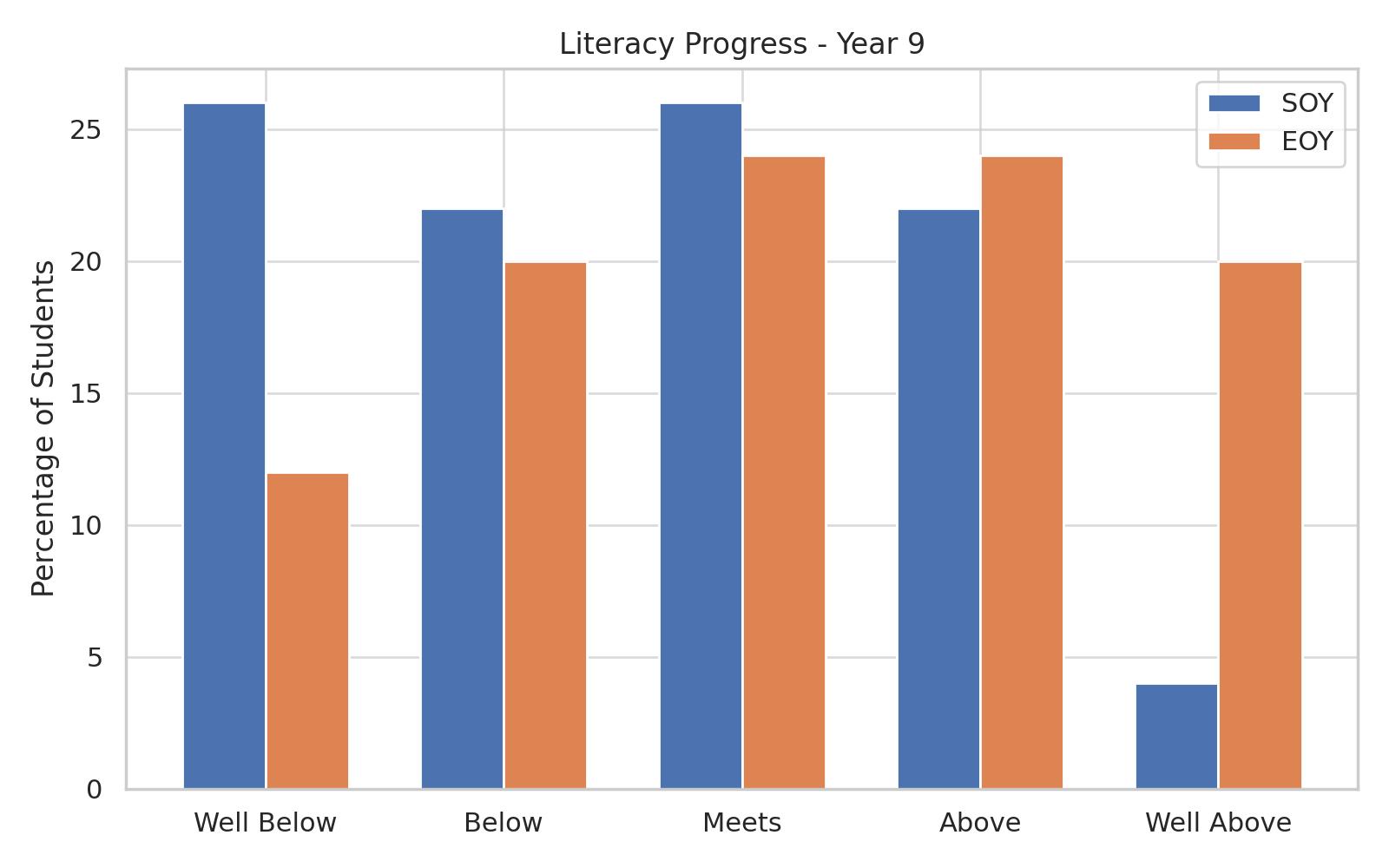
Analysis:
Reduction in "Well Below" and gains in "Well Above" (4% → 20%). Non-Māori students outperformed Māori, highlighting a need for equity-focused support.
Māori vs. Non-Māori Students
- Māori students:
- Half reached "Above."
- No students in "Well Below."
- Non-Māori students:
- Higher proportions in "Well Above."
Gender Differences
- Male students:
- Progress across all bands.
- Reduction in "Well Below."
- Female students:
- Strong gains in "Well Above" (0% → 33%).
Writing

Analysis:
Mixed performance. Slight gains in "Above," but "Well Below" remained significant (32%).
Māori vs. Non-Māori Students
- Māori students:
- Static results with few high achievers.
- Non-Māori students:
- More movement across the bands.
Gender Differences
- Male students:
- "Well Below" increased.
- Female students:
- Gains in "Above" and "Well Above."

Analysis:
Marked jump in "Above" (9% → 28%). However, all Māori students remained in "Well Below," warranting urgent intervention.
Māori vs. Non-Māori Students
- Māori students:
- 100% remained in "Well Below."
- Non-Māori students:
- Gains in "Above" and reduction in "Well Below."
Gender Differences
- Male students:
- Substantial drop in "Well Below."
- Female students:
- Gains in "Above," drop in "Meets."
Reading

Analysis:
The cohort showed encouraging movement out of the lowest band ("Well Below" 33% → 20%).

Analysis:
A stable cohort with incremental gains in the "Meets" category. More challenge and extension needed for high achievers.

Analysis: Overall Growth
- The proportion of Year 10 students in the "Well Below" category decreased from 52% to 23%, indicating significant improvement.
- The proportion of students meeting expectations jumped from 21% to 55%, showing strong progress.
- The number of students achieving "Well Above" increased slightly from 0% to 5%.
Māori vs. Non-Māori Students
- Māori students:
- "Well Below" dropped from 50% to 25%.
- A shift into "Below" (0% to 25%) and "Above" (0% to 25%).
- Non-Māori students:
- "Well Below" dropped from 53% to 22%.
- The number of students meeting expectations increased from 18% to 61%.
- A small percentage (6%) moved into "Well Above."
Gender Differences
- Male students:
- "Well Below" decreased from 50% to 20%.
- "Meets" increased from 38% to 50%.
- A few moved into "Above" and "Well Above" (10% each).
- Female students:
- "Well Below" decreased from 55% to 25%.
- "Meets" increased from 9% to 58%.
- No female students reached "Above" or "Well Above."
Endorsement

Analysis:
Six students were awarded the National Certificate of Educational Achievement, all with Merit endorsements. This indicates a solid cohort working at the Merit level, but the lack of both Excellence and Achieved-only endorsements suggests limited differentiation. The absence of any students gaining Excellence is a key concern and highlights the need for better extension and challenge for high-achieving students.
Equity Considerations
- Gender: Male students comprised the majority of award recipients.
- Ethnicity: European students were overrepresented; Māori student achievement requires closer support.

Analysis: Performance at Level 2 showed broader distribution across endorsement levels. Merit and Achieved were prevalent; some students reached Excellence. No major gender disparity, but females achieved higher endorsements. Māori student achievement improved compared to Level 1, especially in Merit.

Analysis:
A smaller group reached this level. Most results fell in Achieved and Merit; few students reached Excellence. Female students outperformed males, especially in literacy-based subjects. Māori students were underrepresented, requiring long-term strategies for equity.

Analysis:
UE attainment was below national averages. Few students reached this benchmark, with most from the highest-performing groups. Increased focus needed on course design, mentoring, and aspiration-setting to improve future UE rates.
During 2024 the following actions were taken to help us give effect to Te Tiriri o Waitangi
• Culturally Responsive Pedagogy team met regularly, they completed the following:
o Completed walkthrough observations to establish how culturally responsive teaching and learning was
o Drove a change in classroom environments to become more reflective of the bicultural composition of Aotearoa
o Shared attendance, pastoral and academic data with staff
o Shared student voice with staff
o Visual representation of the school values were created and then used to enhance and renew signage around the school
• Staff Professional development:
o Aotearoa Histories curriculum PD
o NCEA Level One Mana Orite PD
o Nihi taniwha
• Staff learned and performed new waiata at the annual cultural competition
• Students all learned school and additional waiata and haka
• Karakia has become common place in many classrooms at the start of lessons
• Curriculum
o Te Reo was offered at all levels of the curriculum.
o All Year 7 and 8 students completed a course in Māori
o All junior students learn NZ Histories
Reporting on the principles of being a Good Employer
How have you met your obligations to provide good and safe working conditions?
What is in your equal employment opportunities programme?
How have you been fulfilling this programme?
How do you practise impartial selection of suitably qualified persons for appointment?
Tokomairiro High School has an active Health and Safety Committee which oversees the school’s Health and Safety Policy and associated procedures. These are available to all staff. The policy is regularly reviewed.
Our Equal Opportunities programme and practices are framed by the school’s Employer Responsibility Policy. The programme has been fulfilled in our advertising and hiring practices. Professional development is provided to all staff based on need and personal growth requirements and aspirations. Reported incidents of discrimination, harassment and bullying are investigated and a complaints process to address concerns is followed.
Positions are advertised in as wide a range of media as possible. Applications are reviewed by more than one individual, and shortlists are drawn up based on input from a number of interested parties. Appointment committees carry out interviews and take references, Appointments are made based on suitability to perform the role, not on sexual orientation or preference, age, ethnicity, religious or political beliefs.
How are you recognising,
- The aims and aspirations of Māori,
- The employment requirements of Māori, and
- Greater involvement of Māori in the Education service?
How have you enhanced the abilities of individual employees?
Whenever possible Tokomairiro High School endeavours to ensure that local hapū and individuals have a voice in decision making and the direction of the school. The school, as part of the Community of Learning, is pursuing the creation of a cultural narrative for the area, to allow all learners to be aware of how the area’s past has been shaped. The school’s Culturally Responsive and Relational Pedagogy team actively seeks to ensure that every classroom is a safe space for students to discover their own cultural identity and to make it part of who they are and how they learn.
Māori at Tokomairiro High School are valued for their contribution as Māori, and staff are encouraged to take advantage of opportunities to incorporate tikanga into our daily operations. The school adheres to section 3.5.1 of the Secondary Teacher’s Collective Agreement.
How are you recognising the employment requirements of women?
Tokomairiro High School employs a robust professional growth cycle for small groups of staff. New and young teachers, and staff appointed to new positions of responsibility are mentored by the school’s Specialist Classroom Teacher. All staff have access to the school’s Professional Development Budget. Staff are encouraged to take advantage of additional training and skill development opportunities as they arise.
Employment requirements of women are met through flexibility when an individual (not only women!!) are required to bring children to school, for example, or
need time off to see that Parental Leave requirements laid out in the Collective Agreement are satisfied. We are flexible around things like medical appointments or other leave required for expectant mums. Planning of trips accounts for the need to be aware of the need to ensure that facilities available when carrying out teaching or supervision outside the classroom meet the requirements of women. Efforts are made through education opportunities to limit misogyny in the workplace.
How are you recognising the employment requirements of persons with disabilities? At Tokomairiro High School employment requirements of persons with disabilities are met in a variety of ways. Staff are afforded time off when required and the school works closely with organisations like ACC to ensure that the needs of individuals are met. The school site is accessible.
Good employer policies should include provisions for an Equal Employment Opportunities (EEO) programme/policy. The Ministry of Education monitors these policies:
Reporting on Equal Employment Opportunities (EEO) Programme/Policy YES NO
Do you operate an EEO programme/policy?
Has this policy or programme been made available to staff?
Does your EEO programme/policy include training to raise awareness of issues which may impact EEO?
Has your EEO programme/policy appointed someone to coordinate compliance with its requirements?
Does your EEO programme/policy provide for regular reporting on compliance with the policy and/or achievements under the policy?
Does your EEO programme/policy set priorities and objectives? x


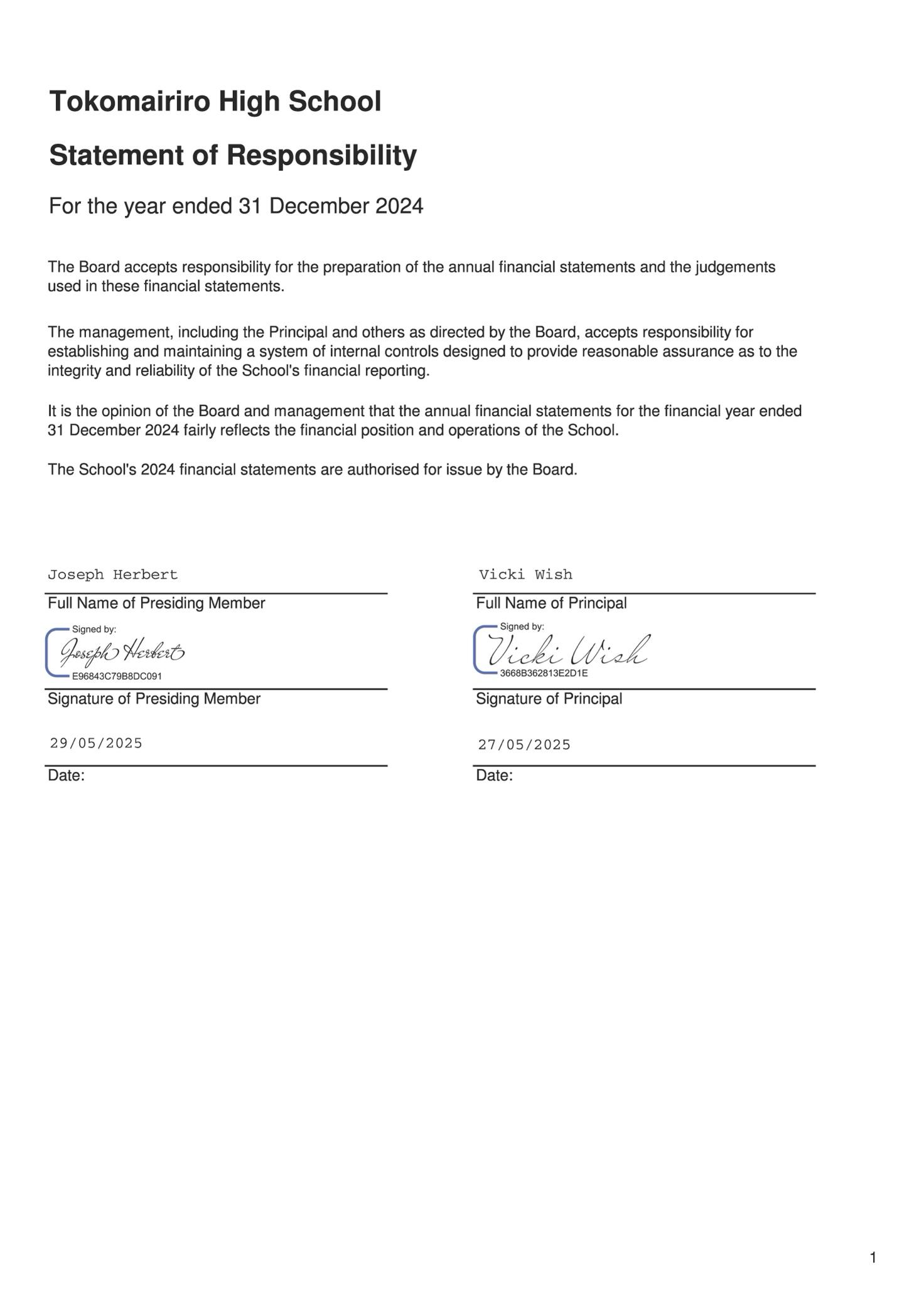
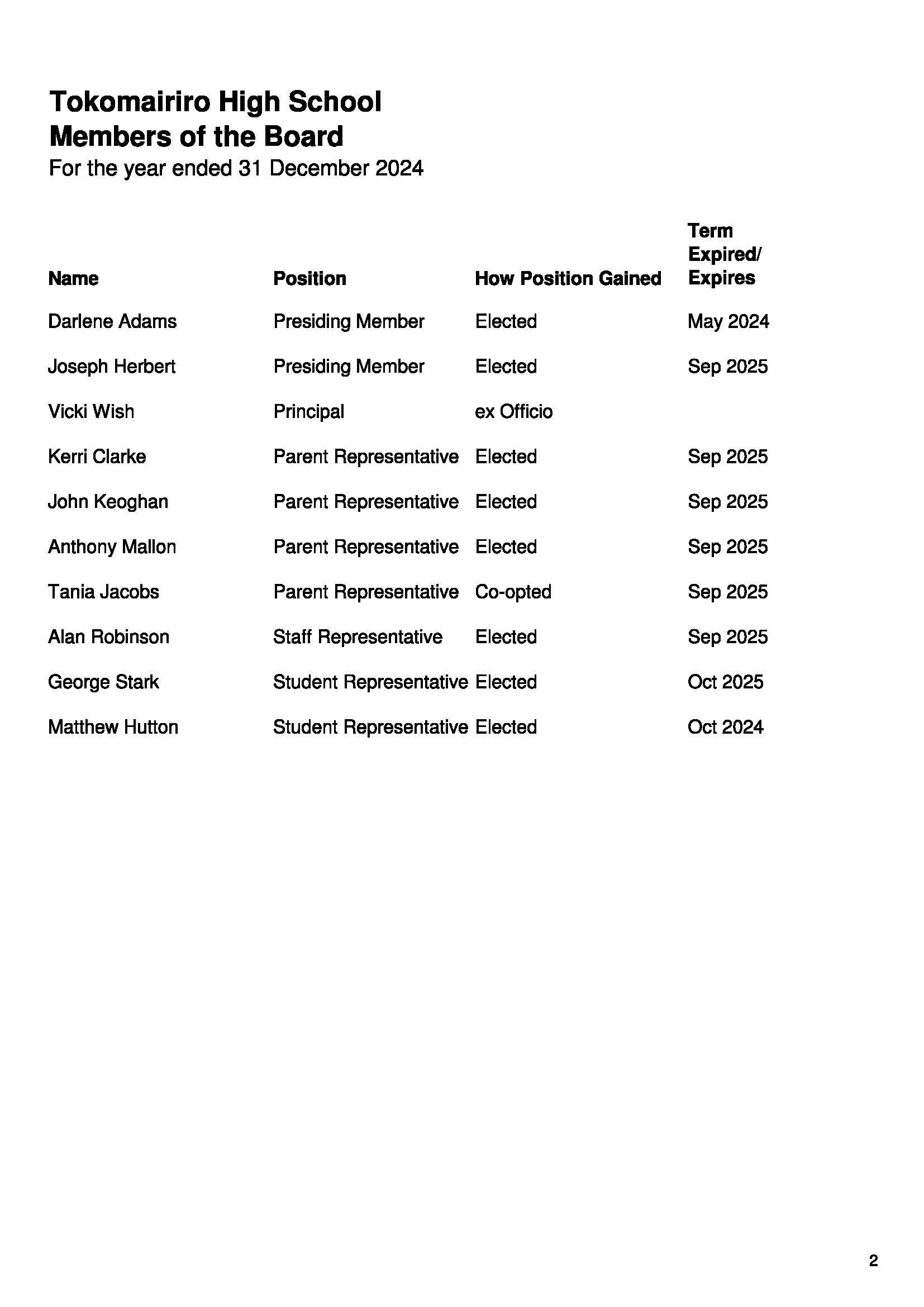






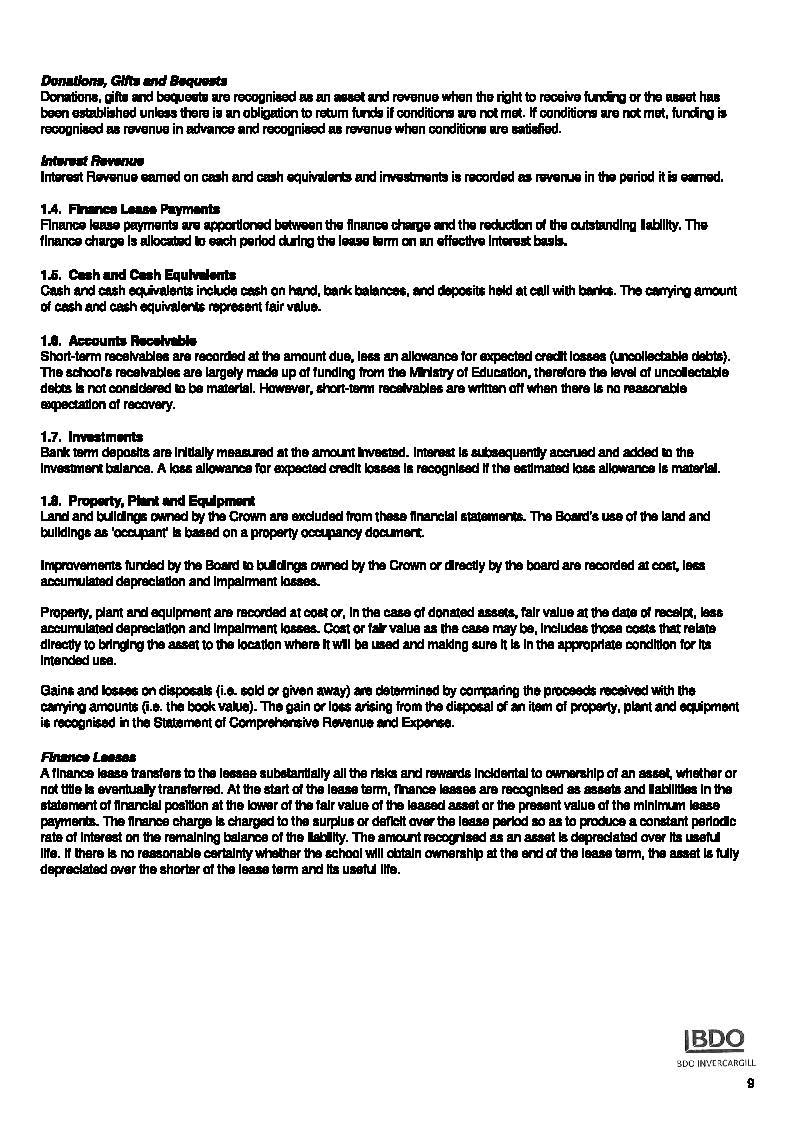



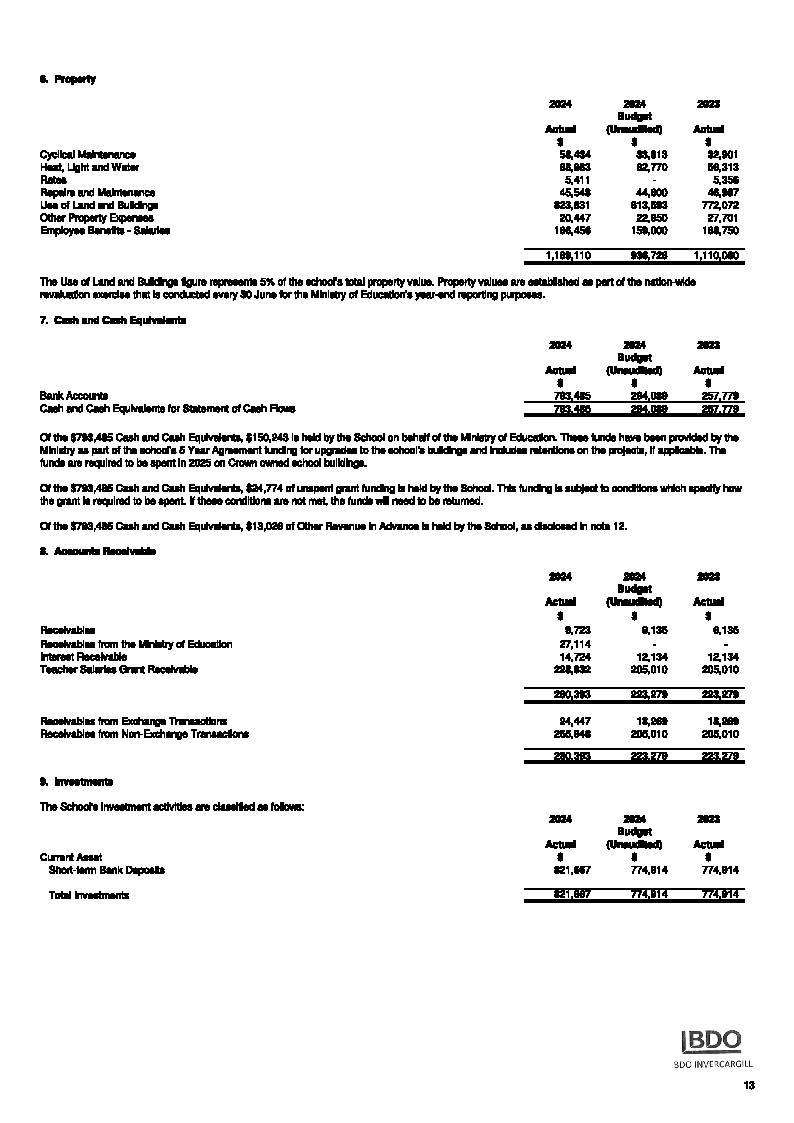





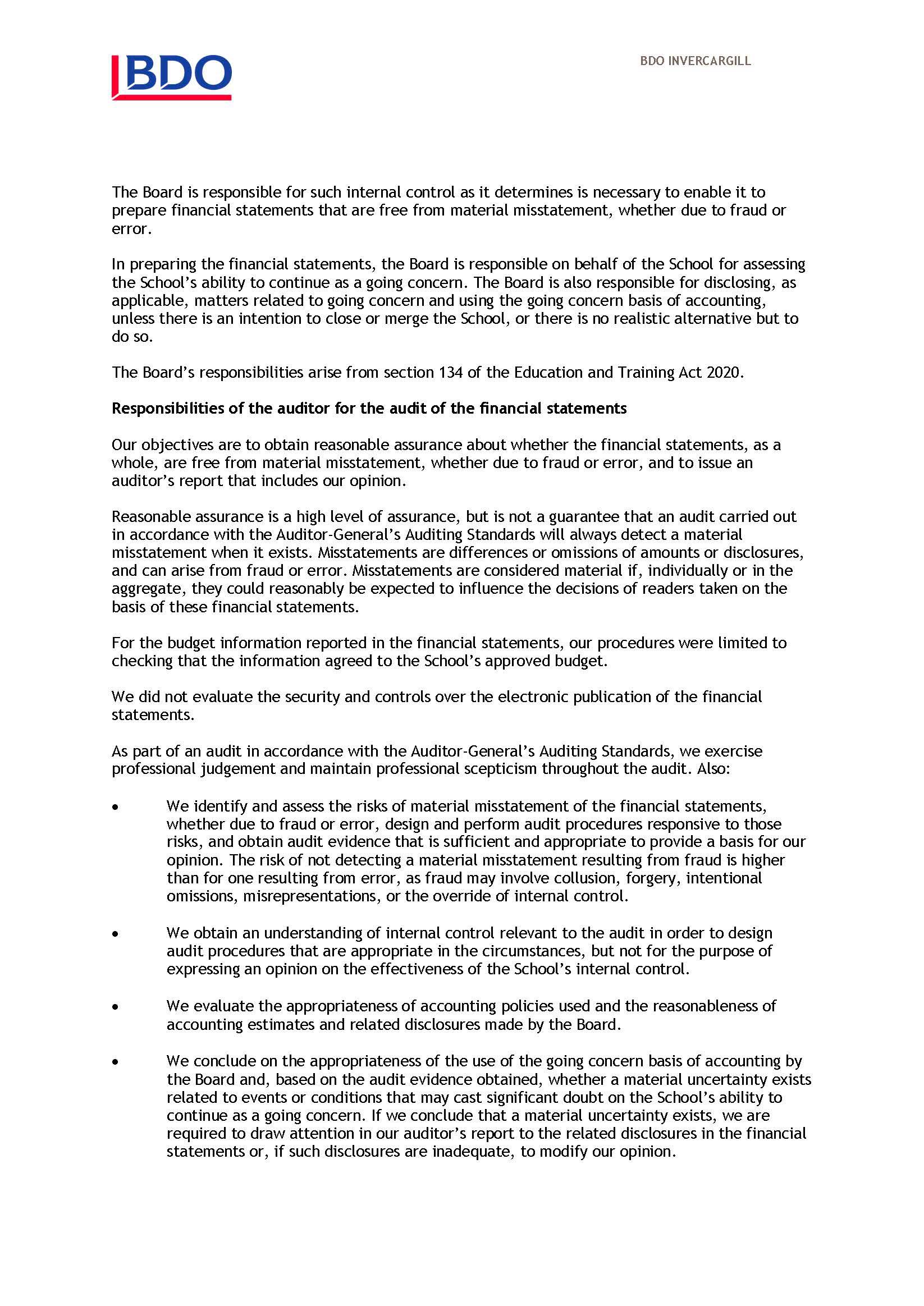
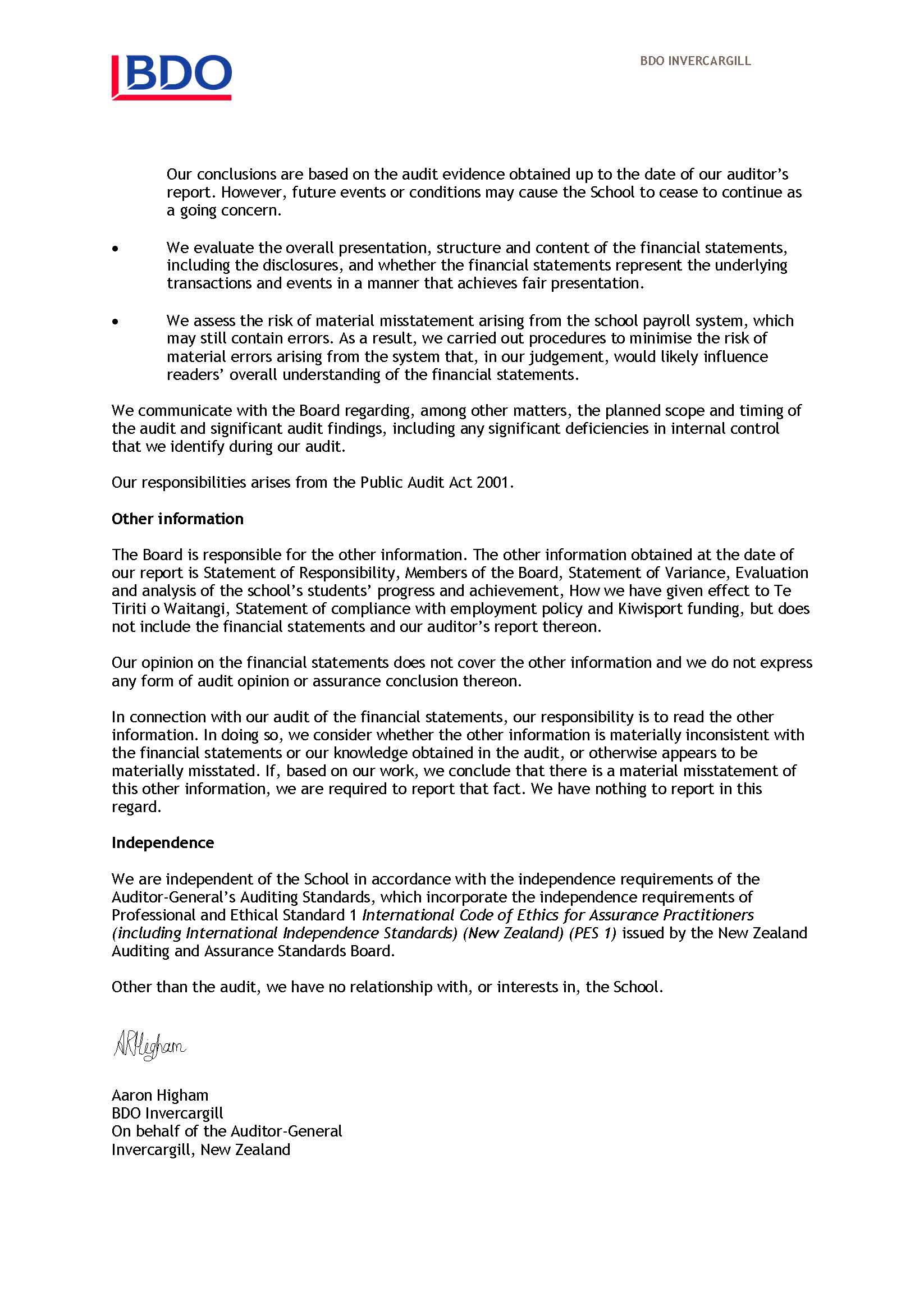
During 2024 the school received contestable funding for ALiM and also ICS.
During 2024 the school received $8000 (excl GST) of funding from ALiM. This money was spent on resources which included specific maths equipment, numeracy rich games that could be used with targeted small groups of students and also subsidised Mathsmate which was a homework resource provided to all students in years 7 to 10 who opted in to the use the resource
The school also received $29,500 (excl GST) ICS funding. This funding was used to support the identified students with Teacher Aide time.
Kiwisport is a Government funding initiative to support students’ participation in organised sport.
During 2024, Tokomairiro High School received a total Kiwisport funding of $4,814.61 (excl GST). The funding was spent on the Sports Coordinator’s wages, outside sports coaches and additional sporting equipment.